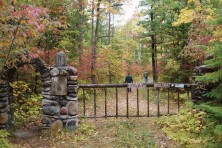Camping in Door County
- Share
- Tweet
- Pin
- Share

In the summer of 1921, Peninsula State Park was 12 years old, and anyone interested in camping at one of its three campgrounds would have paid 21 cents a week or a mere $5 to stay the entire season. Setting up canvas tents on wooden platforms at Shanty Bay (now Nicolet), Welcker’s Point or Weborg Point, campers often arrived with the spring blossoms and stayed through Labor Day, relishing in the easy, self-contained lifestyle of camping in Peninsula.
The tenure and prices of camping in Door County’s state parks have changed during the last century, but the experience of finding a quiet corner to pitch a tent, start a fire and experience the county under the stars is still within reach for novices and experts alike.
Novice Camping
Four of Door County’s five state parks and a plethora of private campgrounds offer a variety of camping experiences for visitors. Peninsula and Potawatomi State Parks are the ideal spots for campers looking to get their feet wet. Kelli Bruns, Peninsula State Park’s superintendent, cites that the campers who frequent the park have a variety of skill levels.
“We certainly have people who come and who’ve never been camping before. They sometimes even have an assumption that we provide those main items when they arrive at the park office,” she explains.
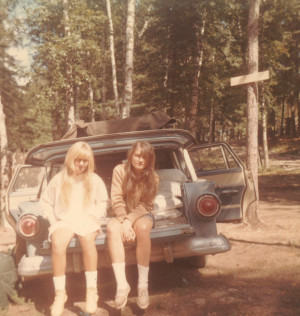
Submitted photo.
In that situation, the staff will direct them to local private stores for supplies, including the Nicolet Bay Camp Store to outfit them for the experience. However, Bruns suggests campers be well prepared for their visit to the park, even if it’s their first time camping.
“Of course, we recommend some kind of a tent. In my own experience, having a good tarp or two for underneath the tent helps immensely in keeping everyone and everything dry. Here at the park, we talk about investing in quality gear. At the park level, if you buy something that’s no good, then it ends up in the dumpster, negatively contributing to waste,” says Bruns.
In addition to a high-quality tent and tarp, Bruns recommends a good sleeping bag, a sleeping pad and enough layers to stay warm and dry. Peninsula has 473 sites, and every site has a picnic table and a fire ring. There’s a firewood lot in the park, which park officials encourage instead of bringing in their own wood in an attempt to keep out the Emerald Ash Borer.
When it comes to cooking, campers should decide before they come if they intend to cook over the fire ring in a more classic, rustic style or if they prefer to use a camp stove. Planning meals ahead of time and rationing food and utensils will help campers prepare for their stay.
“If campers are uncomfortable cooking at their sites, one of the great things about Peninsula is that they’re so close to town. Families can enjoy the day in the park, grab a pizza, and still have the experience,” Bruns points out.
One of the aspects about camping that has changed over the years is the ubiquitous use of technology. Peninsula State Park has 165 sites with electricity, concentrated in the Tennison Bay and North Nicolet Campgrounds. Even if campers are going for the rustic, non-RV or pop-up experience, they still like to have a place to plug in laptops and smart phones for charging. Additionally, at the non-electric sites, campers can stop by to see the campground hosts, campers who take up residence for the duration of the season. Hosts have charging strips, which provide campers a chance to sit and visit while their technology recharges. At Potawatomi State Park, 40 of Daisy Field Campground’s 123 sites have electricity as an amenity.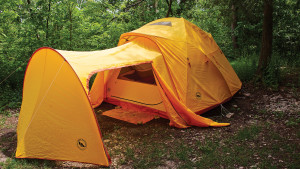
Intermediate/Expert Camping
The convenience of camping with electricity, showers and pull-in sites is ideal for beginners, but for those looking for the next level, camping at Rock Island State Park offers a more remote experience. Off the northeastern shore of Washington Island, Rock Island is only accessible by boat. The rugged beauty and unique history of the island offers visitors a one-of-a-kind experience.
Since there are no cars or roads on the island, camping becomes a more precise endeavor. Visitors need to plan ahead with all supplies and carry them in and out. Additionally, there’s no camp store at the park, so any needs that may arise should be considered before making the journey by ferry or private boat. Small carts are allowed on the ferry and the island, but since space on the ferry is limited, campers need to moderate the amount of items they bring along.
Rock Island has 40 primitive, walk-in tent sites. Drinking water and flush toilets are available near the picnic area and dock, but otherwise campers only have access to pit toilets, making the experience more rustic. In addition to basic necessities such as tents, sleeping bags and sleeping pads, campers should be more prepared for exposure to the elements. Layers of synthetic, quick-dry clothing to keep out the sun and insects are integral, in addition to having high-quality waterproof raingear to minimize the chance of exposure. Campers should also bring solid, durable footwear for making tracks on the scenic trails of the island.
Michelle Hefty, park manager at Newport State Park, describes the type of camping available at Newport to be for advanced intermediates. She gives Rock Island a similar moniker, noting small differences in the skill level required of each park. Newport is one of two parks in the state of Wisconsin to be designated as a Wilderness Park, which has a great deal to do with the philosophy with which the park is managed: with a sustainable, low-impact, Leave No Trace ethic. As such, all of the campsites are backpack only.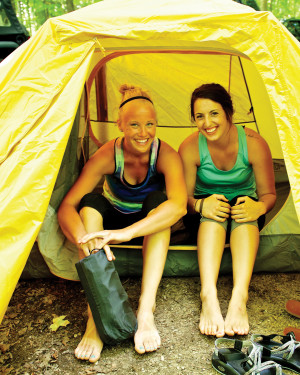
“You can’t really put Newport’s camping in the same category as other Door County camping since we only have backpacking sites. Backpacking is different than pulling up in a car. If people never camped before, and they start by backpacking, they need to consider and plan ahead a great deal more. They’ll need to think about how to preserve food and bring in water…it’s not for the faint of heart,” Hefty said.
Newport has 17 individual sites, all of them only reachable by hiking in one to two miles. At the campsite, there are no picnic tables, only fire rings, a bench and a two-foot metal food container to keep animals from foraging. Since campers are hiking in, their equipment and supplies should be considered not only for durability, but also for their weight.
“[Campers] mostly use very small camp stoves. There are fire rings, but most of our backpackers will end up cooking over a stove. A lot of them will use the dried camping food, in which water is a big source. All the gear generally needs to be smaller and lighter. Equipment like lightweight tents is important because you’re carrying it on your back. They have to ask themselves, ‘What can I live without for a couple of days?’” Hefty said.
One thing campers do have access to is a pit toilet. Each site has its own or shared “Minnesota can,” an open-air toilet on a cement slab. Water, however, is one of the most relevant challenges of being a backpack camper. There is purified water at Newport’s office, but aside from that, campers need to either pack in their water, or purify it by treating it or pumping it. Using smaller water bottles, especially for the ease of day-hiking the trails, will help immensely. The challenge and joy of that kind of camping is exactly what many of Newport’s visitors are looking for: solitude and seclusion.
“I call us the oxymoron for camping in Door County. We’re the opposite of what people come to Door County for. Most people come to the county for a drive-in site. That’s how we differ. At our sites, you don’t see the site next to you or have vehicles driving through…being able to really get out there and get away is what makes us unique. We try to be as rustic and primitive as possible,” said Hefty.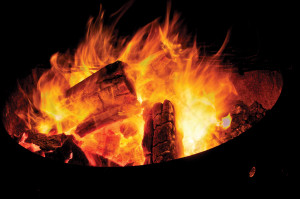
That peaceful solitude is augmented by access to the beautiful 11 miles of Lake Michigan shoreline and Europe Lake, just a short walk from the sites. That solitude comes with a definite need for preparation and at least some notion of what to expect.
“I can usually spot someone who’s never been backpacking before. The ones who have experience pull up, fill up on water, put on their packs and are off. The ones who haven’t done it, or they think ‘hey, this sounds fun,’ they’re trying to unload and figure out how to move supplies. My advice: do your research. Talk to someone, or go with someone, so that they can tell you how to pack a pack and what to expect,” Hefty said.
Food planning and preparation is one such challenge. With a pull-in site, people can haul coolers and all kinds of food, without giving much consideration to things such as refrigeration or weight. With backpack camping, visitors need to consider what will keep and how much everything they carry will weigh once it’s loaded on their back. Additionally, in early summer, Hefty cites the importance of keeping food stowed away from curious animals. The metal boxes in each site have staved off many of the animal challenges other campgrounds may have, but one such critter – the porcupine – is especially persistent. This time of year, porcupines crave salt, so food remnants or even something like a sweaty t-shirt, a bike seat or backpack straps can fall prey to a sodium-seeking porcupine.
“I’ve had people lose leather boots overnight,” Hefty said. “Also, when it comes to pests along the lakeshore, there’s mosquitos and biting flies. Insect repellent or netting is helpful.”
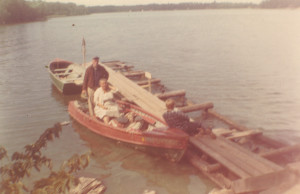
Submitted photo.
Regardless of the skill level or the type of experience Door County visitors hope to have when they pitch their tent, they’re guaranteed to find a memorable space and environment. For all of Door County’s splendor, one thing that continues to bring visitors back year after year is the unique facet of each of the county’s stunning parks.
“What makes us unique is the history of properties and the cultures that are and were here. You’re coming in not only to camp, but to learn. You’re learning about resource protection and history. From the state park standpoint, we have our own unique niche,” Kelli Bruns said.
From novice to expert, that experience is priceless.
Three Must-haves for Camping You’ve Never Thought Of
Eagle’s Nest Hammock

This brand of hammock is light at 16 oz., packs down to a 3.5” x 4.5” bag, and can be strung up happily between two trees anywhere. I’ve used mine everywhere from Cayo Costa, Florida, to Lander, Wyoming. The result is a versatile, incredibly comfortable place to lounge around the campsite or take a snooze after a long day of activity. Crawling into the nest with a good book and some sunshine elevates the experience.
Pudgy-Pie Cooker
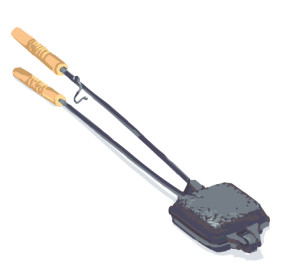
This versatile cooker is perfect for getting creative over the campfire. Most are cast-iron and can be used to cook everything from a grilled cheese to a steak. For most folks, the pudgy-pie cooker is used to roast sandwiches and s’mores alike. The dual-sided cooker can be loaded with two slices of buttered bread, any kind of fixin’s in the middle, and then closed to roast on the campfire coals. The result is a toasty treat under the stars.
Field Guide

These days, “there’s an app for that” seems to be the mantra for people looking for information on the fly. However, my old camping standby continues to be a good field guide for identifying everything from Door County’s wildflowers, the constellations of a September night, or that pileated woodpecker pecking away at dusk. My favorites: Door County Wildflowers: A Field Guide for the Curious by Frances M. Burton and Aurelia M. Stampp and National Audubon Society Field Guide to the Night Sky. Additionally, depending on where you choose to camp, a good history book on the park you’re in makes the visit much more enriching. For example, Door County’s Emerald Treasure: A History of Peninsula State Park by William H. Tishler is captivating and wonderful.
Photography by Len Villano.
Illustrations by Ryan Miller.

